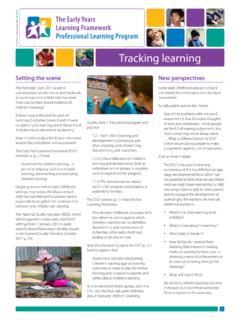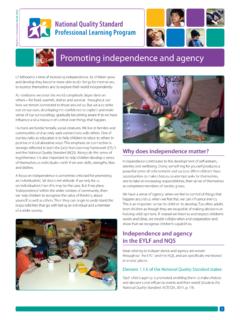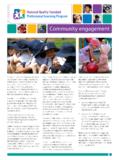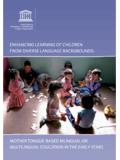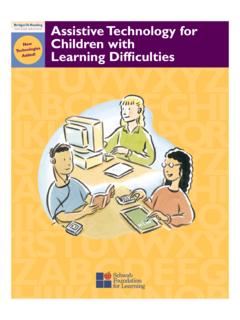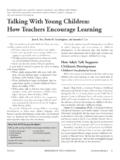Transcription of Communicating with families about children’s …
1 1 NQS PLP e-Newsletter 2013 Communicating with families about children s learning Educators and families have always communicated when necessary, for example, when a child s behaviour is a concern or symptoms of illness appear. Current thinking about good quality practice extends communication beyond such everyday essentials, as families , educators and children collaborate to support children s learning . The national Early Years learning Framework (EYLF) (DEEWR, 2009) and the National Quality Standard (NQS) (DEEWR, 2011) highlight such in the NQS: Element : families have opportunities to be involved in the service and contribute to service decisions (DEEWR, 2011, p. 11). Standard : families are supported in their parenting role and their values and beliefs about child rearing are respected (DEEWR, 2011, p. 11). Element : The expertise of families is recognised and they share in decision making about their child s learning and wellbeing (DEEWR, 2011, p. 11). Communication in the EYLF:Principle: Partnerships (DEEWR, 2009, p.)
2 12)Practice: Assessment for learning (DEEWR, 2009, p. 17)The learning Outcomes and other concepts in the EYLF for example, belonging, being and becoming, agency and dispositions towards learning are the focus for collaborative conversations through which educators communicate more than what the child did to talk about what each child appears to be learning . The aim of communication is not for families to become familiar with the language and terminology in the EYLF. The language in the EYLF is for educators; however, the concepts are for everyone who supports children s content that follows contains quotes from two educators and a parent: Denise is the coordinator of Boroondara Kindergarten, a community-owned and-managed service located on the edge of a public housing estate in Melbourne. Michelle is the manager of children s Programs, Gowrie Victoria Docklands, a centre that provides care and education daily to 150 children in the Melbourne CBD. Emily is the parent of three-year-old Della.
3 They began using family day care when Della was nine months old and now use a centre-based service as well. 2 Everyone benefits from communicationWhen families , educators and children s perspectives, insights and information combine, everyone benefits, particularly the child. Communication builds for everyone a more complete picture of the child s interests, needs, learning progress and uniqueness. This more complete picture informs the child s experience both in the early childhood setting and at home. Denise spoke about combining perspectives: What we re trying to do is to give families a snapshot of what their child is like at kindergarten so that we have a shared understanding. We encourage them to share what the child is like at home. Some do and others don t. We ask questions about what we see and know about that child. We want to know how that matches with what they know and see. Sharing information makes learning more spoke about gaining insights about Della s learning :Janani, my family day care educator, helps me to see so much more than I would otherwise.
4 For example, I might just see Della playing in the sandpit, and Janani will tell me about what she s learning how she s experimenting with materials, using her imagination and planning ahead. families are reassured that their child is known, valued and treated as an individual. Trust and confidence in the early learning setting they have chosen for their child are we first started I felt a bit guilty and unsure. I thought she might be missing out on experiences. I quickly began to see the opposite how she was having wonderful experiences and opportunities that she wouldn t have if she wasn t in care. What I love are the personal stories about Della. I knew early on that Janani could only know those things if she really paid close attention to Della. (Emily) Educators can normalise behaviour: As a new parent you get anxious if your child s not doing something that other children are doing. Janani was always telling me about the range of normal or common behaviour. She has worked with many children , so when she says This is common don t worry about it I know she knows what she s talking about !
5 (Emily) families can learn how educators are helping their child prepare for school and life when they talk about the skills and understandings children gain through the curriculum, including those related to literacy and numeracy. Michelle explains:One of our challenges is to broaden families notions of what readiness is to help them see that school readiness begins at birth by supporting a child s sense of agency, allowing them to make some decisions and take some responsibility for their learning , supporting them to become confident and flexible. We try to help families see the learning that is occurring for example to see that lunchtime isn t just about eating, but offers so many opportunities for various kinds of learning . Michelle summed up the aim of Communicating : What we re aiming for with families is for them to have the knowledge and confidence to make informed decisions about their children . It s not about us educating them or telling them what to do we want them to be involved thinkers and do educators communicate with families about children s learning ?
6 The short answer to the question above is in a variety of ways : We communicate about learning in many ways display boards, emails, newsletters, notes on an easel outside the room, notes in information pockets. We found out from a survey that families have different preferences. We will never be 100 per cent successful no matter how wide the ways of Communicating . There will still be families who don t get information or who don t think there is enough communication. Part of the reason for this is that families are busy they don t have time to read everything. We need to reflect on what communication families really need and want. It s not as simple as the more the better. (Michelle) While all ways of Communicating have value, a face-to-face chat, when possible, is best. The key to effective communication is doing everything you can to make families feel welcomed and establish a positive relationship. When families are welcomed, they witness our relationships with children , they see that we engage with them.
7 We don t have to tell them we care about their child. They can see that. (Denise)Let s focus on some specific points about Communicating : Communicate as much as possible in families first language. Our kindergarten chooses to employ staff who speak the range of families first languages. This is so important, especially if we have a concern or need to tell a family about something that happened. (Denise) Tell families about your practices why you do things the way you do, changes you are considering or have made and their impact on children s learning . Consider the value of projects that extend over days or weeks. Works in progress can provide tangible evidence of children s learning . Share information about the EYLF and the NQS, and make records of children s learning available. Recognise and respect that there will be varying levels of interest in this information. Think carefully about the distinction between records you might make for yourself and your colleagues and those that have meaning and are useful for families .
8 Use photos to illustrate what children do, but recognise their limitations as a means of Communicating about learning a picture on its own isn t worth a thousand words; words are a necessary addition. Seek families advice about their child. Set the stage for the habit of Communicating and building a relationship with the first encounter: We start the process of building relationships at the enrolment interview. Our first question is What is something your child does that makes you proud? We ask about issues during pregnancy and birth, who looked after the child in the first year and who helped the family during that time. We ve found that information to be really helpful in getting a picture of the child s health status as well as the family s connections and ask if they are happy with the way the child eats and sleeps. Questions like these aren t confronting. They demonstrate to families that they can tell us things we need to know. This sets up the idea that we want to know what they know about the child.
9 Of course we accept that some people won t want to tell us their story and we respect that. (Denise) Give all the positive feedback you can about children s progress, interests and positive we will share straight away if it s good news, why delay? Say it then and there. (Denise) Think carefully about whether or not you need to talk to families about a concern, and if you decide to do so, use empathy to consider how you will talk about it. 4 Denise reminds that discussion isn t always necessary: We are professionals we can tell if something is wrong we don t have to ask. We can observe a child and use what we know about that child to follow up. We respect families privacy and their decisions about what to tell us. We follow up straight away if there s something we need to talk about . These follow ups are usually teacher-initiated. We can tell if a family member has a concern. For example, if a parent frequently asks How s he going? or Did she hit anyone today? we know that they are concerned.
10 We are aware that families don t want to hear repeatedly about problems or concerns. We have a family of a child with a disability who keeps postponing meetings that we ve scheduled. We understand the meetings they have to attend about their child probably exhaust them. We try to frame things positively. For example, we might say Your child is a fantastic decision-maker, but once he makes up his mind it s difficult to change it , rather than talking about the child being inflexible. After all, being able to make decisions is a good thing a child initiating their own learning . Convey both optimism and honesty when Communicating about a concern you have about a child. Even when you are struggling to find a solution, aim to communicate a firm belief that a solution can be found. Keep in mind that communication about children s learning includes both general information and information about a specific child. Share with families both general information about children s learning and information about their of the things we should always be reflecting on is improving educators abilities not only to recognise and support children s learning but also to articulate it in ways that resonate with families .

